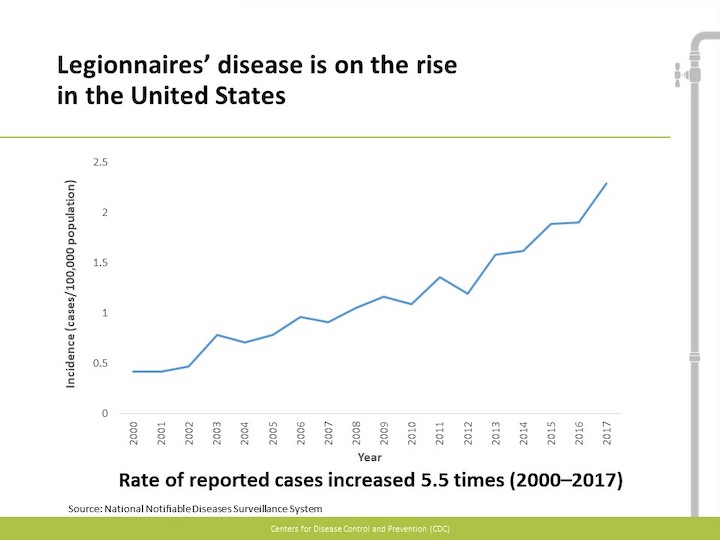Legionnaires’ disease illnesses are on the rise, according to the Centers for Disease Control and Prevention (CDC). Since 2000, the rate of reported cases of legionellosis has more than quintupled but health officials aren’t quite sure why. Is it better reporting? Or, does it stem from an increase in the segment of the population that is susceptible to this severe form of pneumonia?

What is Legionnaires’ Disease?
Legionnaires’ disease (LD), also called legionellosis, is a severe form of pneumonia caused by Legionella bacteria that is sometimes fatal. A less severe form of the infection is called Pontiac Fever. People get LD when they inhale water mist that contains Legionella bacteria.
Although Legionella bacteria are found naturally in the environment, they grow best in warm water usually in complex water systems of large buildings or cruise ships, hot tubs, cooling towers, hot water tanks and decorative fountains.
The incubation period for LD ranges from two to 14 days. Symptoms of an infection include cough, shortness of breath, high fever, headaches and muscle aches.
Who is at Higher Risk for Legionnaires’ Disease?
Some people are at elevated risk for contracting LD. They include people over 50, current or former smokers, people with chronic lung disease, and people with weakened immune systems.
In 2017, health departments reported 7,500 cases of Legionnaires’ disease in the United States. But the CDC believes that many cases go under-reported.
Legionnaires’ Disease Lawyers
The Pritzker Hageman Legionnaires’ Disease Team represents clients nationwide who have been sickened and the families who have experienced the wrongful death of loved ones. Fred Pritzker and Eric Hageman are the lead attorneys for these cases. For a free consultation about a Legionnaires’ disease lawsuit, you can contact them with this online form. Or, call 1(888) 377-8900 toll-free.
Related
Legionnaires’ Disease | Hospital Lawsuit
Legionnaires’ Disease from Hospital Water Supply
Can You Sue a Hospital for Legionnaires’ Disease?
,